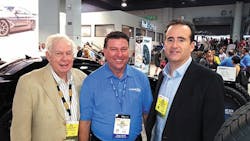Industry Analyst Predicts Higher Tire Prices, Better Volumes
All the pieces were in place for a robust year for America’s tire dealers. Falling gasoline prices. More miles driven. Improving labor markets and an expanding car parc.
But it never came to be.
“Despite a very favorable macro backdrop, sell-out trends in the passenger and light truck replacement tire market were more tepid than most people projected at the start of the year,” said industry analyst and Modern Tire Dealer columnist Nick Mitchell.
“Our best guess is demand, measured in units, at retail was flat to up 0.5% through the first 11 months of 2016.”
That’s a much more somber picture than the one dealers painted at the start of 2016, when they predicted volumes would increase 2% to 3% during the year.
It’s also an explanation for the five words Mitchell used to summarize the year: “Volumes weaker than most projected.”
But there is hope, Mitchell said. “The good news is sell-out trends were stronger in the second half of 2016 than in the first half of the year, the macro backdrop remains favorable, and weather trends appear to be normalizing. As such, most dealers are telling us they expect domestic passenger and light truck replacement tire units to be flat to up 2% in 2017. This view is consistent with our expectations.” So who will benefit the most? “We anticipate the large chains and new car dealers will outperform the smaller operators in 2017.”
Before we dig into the details, MTD asked Mitchell for a five-word prediction for 2017. Turns out, he only needed four words for his forecast: “Manufacturers need higher prices.”
MTD: How would you summarize the tire industry in 2016? Where is the industry headed in 2017?
Mitchell: This past year ended up being softer than most people projected, myself included. Unseasonably warm winter weather weighed on sell-out trends in the passenger and light truck replacement tire market in the first six months of the year. Additionally, the industry did not get any help from original equipment shipments to light vehicle producers, given the slowdown in new car sales. The truck tire market was plagued by weaker OE shipments and an overhang from aggressive pre-buying activity ahead of the tariffs on commercial truck tires imported from China.
I think volumes across nearly every category, with the exception of shipments of passenger and light truck tires to the auto original equipment manufacturers, will be stronger in 2017 than over the past 12 months. Our base case assumes prices on light vehicle tires will move up throughout the year to cover the building pressures from higher raw material prices. Furthermore, we believe prices will go higher on truck and bus tires, largely in response to the recent tariffs on Chinese-produced products and dwindling inventories of tires purchased in the pre-buying frenzy.
Any success in reducing low quality tire capacity in China would be a huge win.
MTD: What should tire dealers expect when it comes to raw material prices in 2017?
Mitchell: At this point, I would say most people on the manufacturing side of the industry think raw material prices will be up 5% to 10% in 2017. This seems like a safe bet given the current prices in the spot market for the key raw materials. Right now, we think the increase will be within this range. That said, views on this front can change quickly given the volatile nature of the commodity markets.
MTD: What’s the forecast for tire pricing in 2017?
Mitchell: At this point, I think it is nearly unanimously accepted that the basket of raw materials will be higher in 2017, led by higher oil and natural rubber prices. The industry is working hard to keep supply in line with demand, with an eye on managing margins, so I think the manufacturers should be able to cover a large chunk, or perhaps all of the cost pressures, if they build slowly rather than quickly due to exponential moves in the prices of key raw materials. The magnitude of the price changes will be determined by the size of the move in the commodity markets.
MTD: What are your new year predictions for the Big Three: Goodyear, Bridgestone and Michelin?
Mitchell: All three will work hard to exploit the trend toward high-value-added tires, especially those 17 inches or greater. All three will benefit greatly from the recent truck and bus tire tariffs. We think all three will work to drive industry pricing higher to offset the pressure from rising raw material prices.
MTD: A year ago you said Falken Tire Corp. was the “manufacturer to watch” in 2016. Has it lived up to your expectations?
Mitchell: Yes; it is still early, but you are seeing early signs that Falken really wants to grow its market share in the U.S. Earlier in the year, the manufacturer announced plans to expand its plant in Tonawanda, N.Y. More recently, it unveiled a plan to develop a R&D tech center in the U.S. and upgrade its tech track to speed up innovation. These actions are clear signs that Falken has high aspirations.
MTD: Which manufacturer is the one to watch in 2017?
Mitchell: Here is a little bit of a curve ball: all of them. This year will be dominated by whether the manufacturers put the interest of the group over their own well-being. The industry needs to take prices higher in 2017 to offset the building pressures from rising raw material prices. If a few producers hold price firm in an effort to steal market share, it will be a tough year for all parties.
MTD: What’s the next merger you anticipate in the industry?
Mitchell: I think the next merger or acquisition will likely include Kumho or Cooper. In our opinion, the latter remains an attractive target for foreign manufacturers that lack a robust footprint in North America, or an established producer that is looking to increase its market share in the all-important U.S. market.
MTD: What’s happening with tire production in China? Is consolidation there really occurring?
Mitchell: We continue to hear of increasing consolidation in China and that the Chinese government is trying to dramatically reduce excess capacity through environmental regulation. Recall a few years ago they tried to achieve this same goal by restricting credit from state-owned banks to these factories. Unfortunately, the data is not good enough to know for sure this is occurring, but the anecdotal commentary from people closer to the situation suggests these two latest factors are starting to have an impact on capacity in the country. Needless to say, any success with efforts to reduce the number of Tier 3 and Tier 4 producers and/or the amount of low-value added capacity in the country would be a huge win.
MTD: Who/what poses the greatest threat to the business of independent tire dealers in 2017?
Mitchell: Consumers’ growing desire for a better experience. Those who do not adapt to the growing preference for clean and updated waiting rooms, fair prices, and honest advice will lose share in 2017 and beyond.
MTD: What’s happening in the auto parts business?
Mitchell: Volumes continue to benefit from an aging car parc, but on the margin, brands are becoming less relevant. SKU proliferation is a growing problem.
MTD: How will the livelihoods of independent tire dealers be affected by the election of Donald Trump as president?
Mitchell: Honestly, it is too early to tell. That said, I believe the fate of the average independent tire dealer will be driven more by their own actions or inactions than any other factor. As such, I encourage dealers to always look for fresh opportunities to grow their business rather than relying on the state of the economy for success. The economy will grow in some years and shrink in others, but the one constant is that there is always market share up for grabs.
MTD: In 2016 Kumho Tire USA Inc. opened its first American tire factory, and Hankook Tire America Corp.’s plant will open in early 2017, with others to follow in the near future. How long until these new tire manufacturing facilities affect life inside the shops owned by independent tire dealers?
Mitchell: A lot of the capacity you reference is geared for the OE channel and is part of an industry shift to adopt near-sourcing strategies in an effort to limit the impact of current and future tariffs, and shorten supply chains. I think these steps will have a positive impact on working capital trends, probably more so for manufacturers and wholesalers than the independent tire dealers.
MTD: What’s the forecast for tire wholesalers?
Mitchell: I think tire wholesalers will see shipments to retailers that are very consistent with consumer demand in 2017, so someplace between flat and up 2%. We expect the large wholesalers will do better than this, with the market share coming at the expense of the smaller distributors. Similar to recent years, acquisitions should contribute to share gains.
MTD: How’s the auto service repair business, and what’s the future of service for dealers?
Mitchell: Demand on the service and repair side of the business was very similar to the trends in the tire category. OK, but not great, and much slower than the forecasts at the start of the year. I think auto service and repair work will grow in importance in the coming years. Service and repair work is a great opportunity to build trust and loyalty with consumers. Dealers who do not take a long-term view of the importance of high levels of customer service on this side of the business run the risk of damaging their brands.
MTD: Are tire dealers doing something now that they won’t be doing five years from now?
Mitchell: Yes. Many dealers are ignoring or underestimating the power of social media. This attitude will change greatly in the next five years. Digital media is making it easier than ever for a consumer to find a soapbox to preach from. Right or wrong, the consumer has a microphone. Installers who do not emphasize customer service and monitor social media posts to quickly rectify consumer complaints will lose market share. Those that take the opposite approach will grow above trend.
MTD: Thanks once again, Nick. ■
About the Author
Joy Kopcha
Managing Editor
Joy Kopcha joined Modern Tire Dealer and Auto Service Professional as senior editor in 2014 after working as a newspaper reporter for a dozen years in Kansas, Indiana and Pennsylvania. She was named managing editor of MTD and ASP in 2022, and took on that same role with Motor Age in 2024.
She is an award-winning journalist, including in 2023 when she was named a Jesse H. Neal Awards Finalist.
Don't miss any of her articles. Sign up for MTD's newsletters.

